This is a Yashica Minister-D, which is a 35mm rangefinder camera made in Japan in 1963. This model was fourth in the Minister line which represented Yashicas’s mid-rage of 35mm rangefinders. The Minister-D signaled a shift to CdS based light meters as opposed to the earlier selenium cell meters. It had a low spec (but still very good) 4.5 cm f/2.8 lens. A variant of the Minister-D with an f/1.7 lens was also released called the Minister-700. All Ministers had mechanical shutters that worked without a battery, and gave the user full control over aperture and shutter speed unlike the model that would replace it, the Yashica Electro.
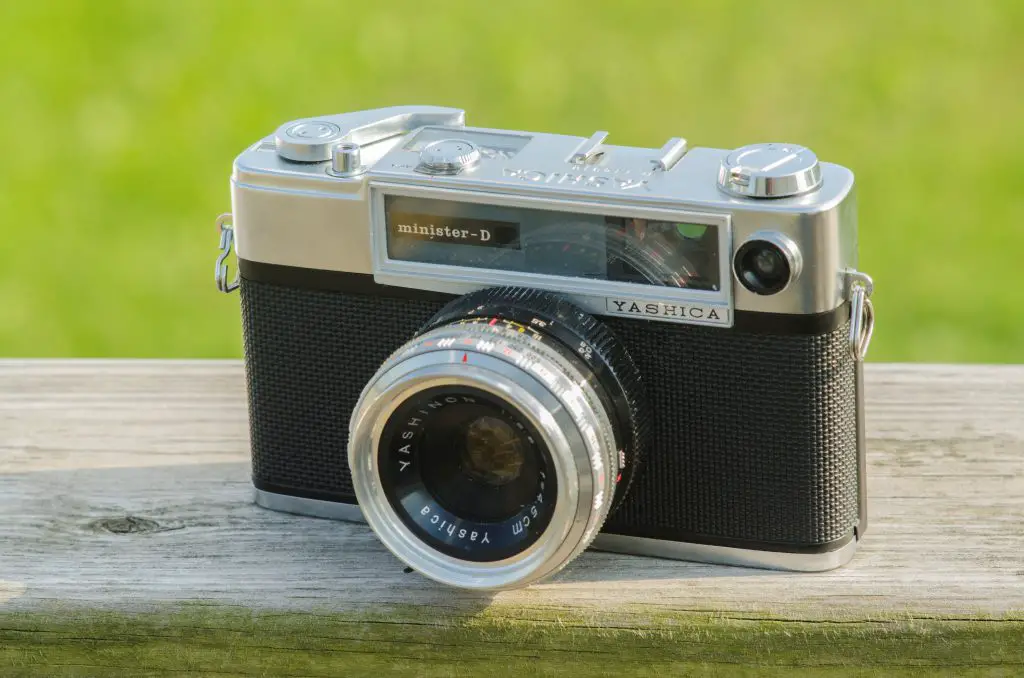 Film Type: 135 (35mm)
Film Type: 135 (35mm)
Lens: Yashinon 4.5 cm f/2.8 coated 4 elements
Focus: 2.6 feet to Infinity
Type: Coupled Coincident Image Rangefinder
Shutter: Copal SVL Leaf
Speeds: B, 1 – 1/500 seconds
Exposure Meter: CdS body mounted uncoupled meter
Battery: PX625 1.35v Mercury (for meter only)
Flash Mount: Coldshoe and M and X Flash Sync
Manual: http://www.cameramanuals.org/yashica_pdf/yashica_minster_d.pdf
How these ratings work |
The Yashica Minister-D is a mid-range camera made by Yashica that often flies under the radar of most collectors. What it lacks in “prestige”, it more than makes up for in ease of use, compactness, and a really great f/2.8 lens. I was lucky to get one in perfect working condition and found the CdS meter to be quite accurate despite the camera being 53 years old. The LVS system on the lens, while unnecessary, was well designed. This is the 4th camera in my collection with an LV scale, and this one is by far the easiest to use. If you have an opportunity to pick up a Minister-D, do it. Chances are, it won’t be expensive. I don’t think Yashica ever made a bad camera in the 1960s. They’re good looking cameras that were built to very high standards, have large and bright viewfinders, and consistently came with sharp and accurate lenses. | ||||||
| Images | Handling | Features | Viewfinder | Feel & Beauty | History | Age | |
| 1 | 2 | 1 | 1 | 2 | 0 | 20% | |
| Bonus | none | ||||||
| Final Score | 8.4 | ||||||
History
The Yashica camera company originally started as two separate Japanese companies both who made cameras along with other products.
In 1940, several ex employees of Canon formed the Kōgaku Seiki Company. In 1942, they released their first model, the Nippon, which was a Japanese clone of the popular German Leica camera.
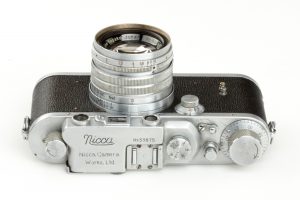
Meanwhile in 1949, the Yashima Seiki Company was founded who primarily made electronic parts for clocks. They eventually moved onto camera parts and released their first camera, the Pigeonflex in 1953 which was based off another German camera, the Rolleicord. In 1948, Kōgaku Seiki Company changed it’s name to Nippon Camera Works, and a year later changed it again to Nicca Camera Works. The company continued to build clones of Leica cameras. Although these early Nicca cameras were not very successful, they remain valuable collector’s items today.
Although both the Yashima and Nicca companies made good cameras, after Japan’s defeat in World War II, not many people outside of Japan were interested in a Japanese copy of a German designed camera. Despite their success at making good cameras, both companies struggled to sell their models in large volumes.
In 1958, Yashima would acquire Nicca Camera Works. They combined the resources of both companies and changed their name to Yashica Co., Ltd. which itself was a combination of both company’s names. Yashica would continue to release new TLR models, but would release two previous Nicca models under the Yashica nameplate, called the Yashica YE and YF which used LTM screw mount lenses. Both of these models strongly resembled the Leica IIIf and would be the last Yashica models with an interchangeable lens mount.
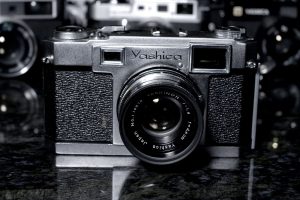
Later that year, Yashica would release it’s first fixed lens rangefinder, the Yashica 35. Although an all new design, this camera had design elements that loosely resembled Nikon’s S-series rangefinder of the same era. With the release of the Yashica 35, the company would begin a decade long blitzkrieg of new TLR, SLR, and rangefinder models. Yashica would release several lines of cameras with nearly constant revisions and improvements.
I won’t cover all of the rangefinders here, but starting in 1960, most Yashica rangefinders were split between the Minister and the Lynx models. The Lynx cameras represented the company’s top of the line range, with higher spec lenses, larger bodies and more innovative features. Each year a handful of new models from both lines would be released.
An early variant of the Minister came with a Yashinon f/1.9 lens and was called the Yashica M. The rest of the line would typically have a lower spec f/2.8 lens. Between 1960 and 1963, the Minister would be revised 4 times receiving incremental updates each time. The first three were the Minister, Minister II, and the Minister III The fourth and final revision was called the Minister-D, which is being reviewed here. I suspect “D” was supposed to signify the 4th letter of the alphabet instead of simply calling it the Minister 4. The Minister-D was the first model to have a battery powered CdS light meter instead of the battery-less selenium cells like on earlier models. Although the meter required a battery, the camera was still completely mechanical and would work even without a battery. There was also a model called the Minister-700 which was the same as the Minister-D, except it had a Yashinon f/1.7 lens.
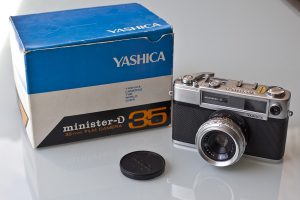
Yashica’s success in the mid 60s was largely due to the Minister and Lynx cameras. They would have later success with their new TL SLR cameras. In 1966, Yashica would release the world’s first fully electronic shutter camera, called the Yashica Electro, taking the place of both the Minister and Lynx lines. All Electros would come with the company’s excellent Yashinon f/1.7 lens and would remain in production for over a decade.
Yashica enjoyed quite a bit of success all over the world during the 1960s and early 70s. Anyone active in the photography industry was well aware of their models. In my time collecting cameras, it seems that Yashica was the only major company to have successful lines of TLRs, SLRs, and rangefinders. Sure, there were more successful models made by other people, but Nikon, Canon and Leitz never made TLRs. Rollei was known for some of the best TLRs, and they did have some SLRs, but they were hardly known for them. Zeiss made models of all three designs, but their greatest success was in their lenses, not in their cameras.
Perhaps it was this division of effort that thinned Yashica’s market penetration in any specific market because by the 1970s, their position in the industry would significantly weaken. In 1973, Yashica would partner with the remnants of Zeiss-Ikon and release a new line of electronic SLRs bearing the Contax nameplate. These were very well built cameras with excellent Zeiss optics, yet they would never reach the level of success of other Japanese camera makers of the time.
Eventually, Yashica cameras would be relegated to “has been” status. In 1983, Yashica would be acquired by ceramics company Kyocera, and would abandon all mid to high end models, concentrating solely on cheap point and shoot models. The Yashica name would continue through the 80s and 90s in name only, and would retain little to none of the original DNA that made the company so successful. Kyocera would retain ownership of the Yashica brand through 2008 at which time the company assets were sold off to various tech groups and over the course of the next few years, would bounce around a couple of more times.
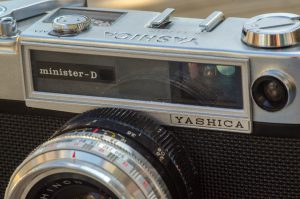
The name Yashica still exists today. The company’s 2016 website is suspiciously spartan with only passing mention of a product line. Any attempt to get more information on current models leads to a dead end.
Today, many Yashica cameras are quite popular with collectors. While the Minister-D isn’t a highly sought after model, people who remember their cameras will rarely have anything bad to say about them. Some Yashica models, especially their TLRs and the Lynx 14 with f/1.4 lens can still fetch pretty good prices on the used market. Some of the lesser known models like the Minister line are rarely sought after, which is great for someone looking to shoot with an otherwise excellent example of 1960s Japanese rangefinder technology.
My Thoughts
I don’t have a great track record buying Yashica rangefinders. I started out lucky with my first Yashica Electro GS which has given me many great shots, but other Yashicas I’ve gotten since then have had a random number of issues. One Electro I was positive was working properly, until I shot a whole roll only to find out that the shutter was only firing at 1/500 for every shot, causing pretty much all of them to be grossly underexposed.
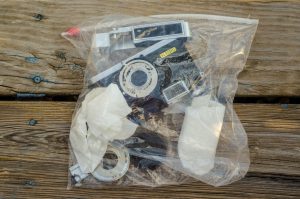
My first Yashica rangefinder that wasn’t an Electro was something called the Yashica M which is actually a top of the line Yashica Minister, but with a faster f/1.9 lens. That camera not only arrived to me with a broken shutter, the entire focus mechanism was extremely stuff, and the lens had a TON of fungus on it. It was the most fungus infested lens I’ve ever seen. Since fungus is actually a living organism, I am not even sure that had the camera been working, that I would have kept it. Some people get paranoid that fungus from one camera can spread to another. While most people suggest that’s not possible, I don’t know that I would have wanted to risk it. That camera currently resides in the St. Ziplock Cemetery in my basement awaiting future disposal.
Next, I got a Yashica Lynx 14 rangefinder with the highly sought after f/1.4 lens. This camera actually seemed to work OK, and even the meter responded, but I could see upon looking through the lens that one of the aperture blades was frozen, giving a soft of “tear drop” shape when you would fire the shutter. Thinking that perhaps the camera was just stiff due to years of disuse, I fired the shutter about 20-30 times, only to have the entire shutter jam and stop working at all. I took the front lens element off thinking I could clean it with some Ronsonol, and quickly learned that the Yashica Lynx 14 lens and shutter is a lot more complicated than I was used to. Not only was I unable to restore functionality to the camera, I got to a point where I couldn’t even put it back together.
I ended up getting a second Lynx 14 which also doesn’t work, but my hope is that between the two, I might be able to piece together one working one from the parts of two broken ones. I am sure I won’t be successful, but hey, I’ll give it a shot!
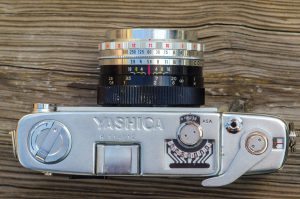
So back to this Minister-D. I acquired this camera in nearly the same way I got the Minolta A5 which I’ve reviewed here. It was listed on eBay for $4.99 with no bids. I bid the minimum amount, not thinking I’d win, but I did. I got the camera for $5 plus shipping and upon receiving it, saw that it was in perfect working order! The viewfinder was pretty clean, the focus and aperture rings all moved smoothly, and most importantly, the meter seemed to work correctly.
Yashica’s decision to put a CdS meter on a relatively low-spec rangefinder in 1963 was a curious decision as CdS meters were still cutting edge technology at this time. Many manufacturers were still relying on selenium cell meters in 1963. Minolta’s SR-7 from 1962 was the world’s first SLR to have a CdS meter and it was considered to be a pretty high end camera at the time. While CdS meters would quickly become the standard in the next few years, the implementation of the meter on the Minister-D is not like those found in later cameras with match needle systems.
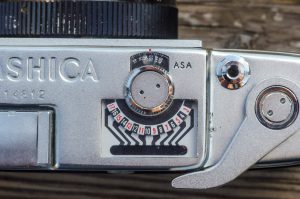
The meter on the Minister-D shows the measured light on the top plate of the camera via a Light Value (LV) system with values from 3 – 17. The LV system predates coupled meters which could detect the selected aperture and shutter speeds of the camera to suggest an accurate light reading. This means that the meter on the Minister-D does not respond any differently to changes to the shutter speed or aperture. The only adjustment for the meter is by selecting film speeds via the ASA speed dial which is directly above the LV scale on the top plate.
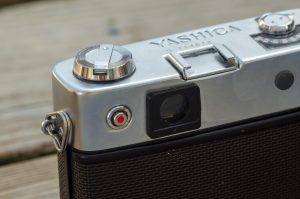
Since the CdS meter is battery powered, you must manually turn it on and off via a round red button to the left of the viewfinder on the back plate of the camera. I found it’s location to be a bit awkward at first, but as it turns out, it’s location is right about where your left thumb would rest when naturally holding the camera. This button is a momentary on/off switch so you must keep it depressed in order to keep the meter on. As soon as you remove your finger, the meter turns back off. Since the rest of the camera is entirely mechanical, when this button is not pressed, there is no drain on the battery. This suggests that a fresh battery in the Minister-D should last quite a long time.
Upon pressing the button to activate the meter, you’ll notice that the needle on the LV scale on the top plate of the camera responds to whatever lighting the CdS “eye” sees. The CdS meter is of an “average metering” design which averages the amount of light detected in an approximately 30 – 40 degree virtual cone in front of the camera. It would be a few more years before “spot metering” would become common. The scale on the LV meter does not list shutter speeds or aperture f-stops, but instead an arbitrary number from 3 – 17 which corresponds to the LV reading. Because the meter is only seen on the top plate of the camera, and not inside of the viewfinder, you have to pay close attention to have the camera pointed in the same location you wish to compose your picture. This was probably the most difficult aspect of using this camera since you cannot read the meter with the camera to your eye and you need to lower the camera into a position where you can physically see it, while simultaneously keeping it pointed at your subject.
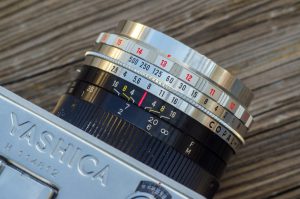
Once you have an appropriate LV number, you then direct your attention to the lens barrel which shows 3 sets of numbers, LV numbers, aperture f-stops, and shutter speeds. I have encountered LV scales on other cameras before, such as the Aires 35-III L , the Flexaret VII, and Kodak Retina IIc, and I never really cared for them. In order for a LV system to work, both the shutter speed and aperture values must be somehow coupled together. Upon adjusting the LV scale, the shutter speed and aperture numbers need to change to equal a corresponding LV reading. The idea was to make exposure calculation easier for novice photographers. Instead of having to understand exposure readings or memorize the Sunny 16 rule, you would simply take the LV number from the scale and then turn one dial on the lens to match that number, and you’d be set. The catch is that on these other models, it made purposely choosing a desired shutter speed for moving objects, or selecting a specific aperture size for control of depth of field to be difficult.
Compared to the LV scale on the three cameras I mentioned above, I have to say that Yashica’s system on the Minister-D is the best I’ve ever used. Unlike those other cameras, there is no external “pin” that couples the aperture and shutter speeds together. Everything is handled inside the barrel of the lens. If the meter suggests LV 11, you turn the dial to LV 11 and you’re done. If you don’t like the aperture size or shutter speed that the camera automatically selects for you, then just change that too, and as long as the LV scale still says 11, your exposure will still be correct. It’s almost too simple. Any twist of the LV scale guarantees correct exposure, but you are free to override it at any time. You can still override the chosen settings on the Aires, Flexaret, and Retinas, but it requires pulling back on a coupling pin while simultaneously adjusting your selected speeds.
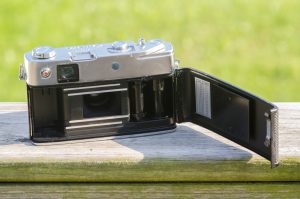
If my written description here doesn’t make sense, don’t worry, if you ever have the opportunity to try out a Yashica Minister-D in person, it will make perfect sense once you try it. For those just reading this review, trust me, the whole system is done remarkably well, and it’s a shame that other cameras with similar LV systems weren’t more like this.
The best thing about this LV system is that you don’t have to use it at all. At it’s core, the Minister-D is a fully mechanical camera that works at all speeds without a battery. If you acquire one with a dead meter, the camera is still completely usable. Even if the meter works, you can just ignore it and the camera is still completely usable. So when talking about the rest of the camera, what you have is a relatively compact, all metal Japanese rangefinder from the early 1960s. The camera has a large and bright viewfinder with an easy to see rangefinder patch. Inside of the viewfinder are parallax corrected framelines for the 45mm lens. The body is built to high standards and predates the widespread use of plastic on the body, even the film transport lever is completely metal.
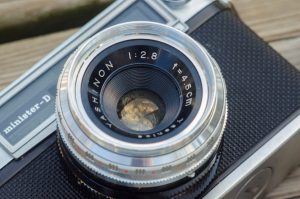
One curiosity with this camera is that the front ring around the lens identifies this lens as 4.5 cm, instead of 45 mm. Although it was common for manufacturers to notate focal length of a lens in centimeters prior to World War II, almost every lens released after the war was measured in millimeters. I find it odd that Yashica would still use centimeters nearly 2 decades after the war ended.
My Results
I first acquired the Yashica Minister-D at nearly the same time as a Minolta A5 rangefinder. Both cameras had very obvious similarities. They were both Japanese rangefinders from the early 60s that were nearly the same size and weight. Both cameras had 45 mm f/2.8 lenses, and both had large and bright viewfinders with a coupled rangefinder and parallax correction. The Minolta does not have a light meter but did have a faster 1/1000 top shutter speed.
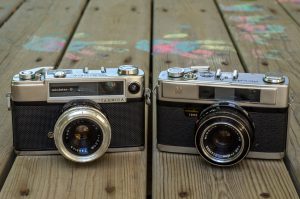
My original plan was to do sort of a face-off and see how the two compared. I had a family trip planned in Eau Clare, WI so I thought that would be the ideal opportunity for my test. As often happens, life got in the way and I didn’t have the necessary time to prepare for a proper comparo, so I threw both cameras into a bag and figured that I would just do my best.
Due to my lack of planning, I didn’t have two of the same types of films to do a true A/B comparison between the two and since the Minolta was loaded first with the only fresh roll of Fuji 200 I had, the Minister-D got an expired roll of drug store 400 film. Knowing full well that the results wouldn’t be comparable, I did the best I could with the Yashica while trying to rely on the light meter. This being the first camera in my collection with a useful LV scale, I felt I owed it a shot.
In use, the two cameras were nearly identical. I had no issues focusing with the rangefinder, and although I made it a priority to use the LV scale on the lens, I found that the top plate exposure meter was awkward. It is a lot more difficult to get an accurate reading of your subject matter while holding the camera in a position to where you can see the meter. This is even more awkward if your subject is a person due to the additional time needed to take a reading. I found that this was a little easier as long as I consistently shot in similar light. Four of the six images below were all shot in a brightly lit park on a sunny day. The last two were just before sunset on a completely shaded porch. So while getting a new reading was a bit awkward, I learned that it wasn’t necessary to get a new reading before each and every picture.
As for the photos, I am quite pleased with the results. As expected, the expired generic film had more grain and slightly muted colors. Comparing the results from the Minolta, that camera’s results were more colorful and natural looking. I honestly expected both cameras to perform nearly identical, and while that may still be the case, I feel as though the film was more to blame than the lens itself.
What I do see here is that the Yashica and Minolta lenses are on par in sharpness. The ease of shooting was nearly the same. Although the Yashica benefits from the light meter, and the Minolta has the faster 1/1000 shutter speed, I can’t honestly say that either improved my images any. I didn’t even need to use the fastest speeds on either camera.
I feel like if I was in a camera shop in 1963 and was considering buying this brand new Yashica Minister-D with the state of the art CdS meter, or the 3 year old Minolta, I might be intrigued by the cool electronics of the Minister, but might feel that the Minolta would be more reliable due to having absolutely no electronics whatsoever. Also, since the Minolta had already been out for 3 years, it’s price probably would have been more affordable. In terms of the photographs that each camera produces, I can’t honestly say that one is better than another…and that’s not a bad thing because both did an outstanding job.
These two cameras are actually quite similar for all of the reasons I’ve already mentioned. Sure, each has a signature feature the other doesn’t have, but in my limited experience, neither made any difference in the results. I can’t even say that the next time I take out this Minister-D whether I’d even use the meter again. Sure, it was a fun experiment, but I think I’d rather just use Sunny 16 to estimate exposure the next time I use it.
Additional Resources
http://camera-wiki.org/wiki/Yashica_Minister_D
http://www.camera.portraits.srv2.com/ministerd.htm
http://retinarescue.com/yashicaministerd.html
https://simonhawketts.com/2015/12/26/vintage-camera-collection-yashica-minister-d-35mm-rangefinder/
https://johns-old-cameras.blogspot.com/2016/01/yashica-minister-d.html
http://www.e-braam.nl/index.php?id=cleaning-the-shutter-of-a-yashica-minister-d

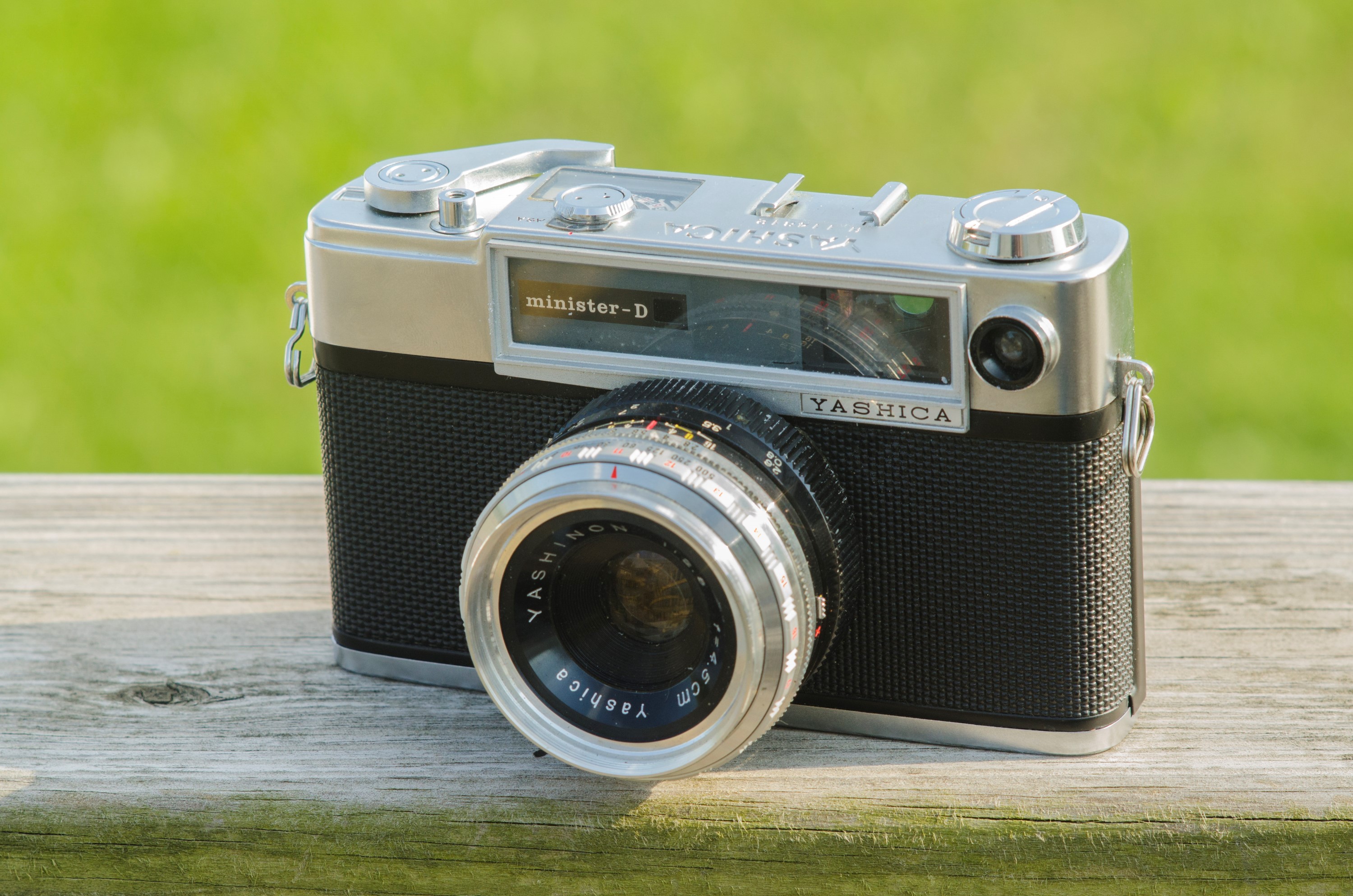
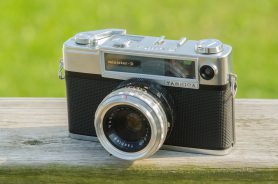






Thank you for perfect review. I am just considering buying Yashica Minister D and this article is a great help! Now I think I’ll get one 🙂
Dominik, you are most welcome! The Minister-D was a $5 pickup for me that I fell in love with. It’s controls are simple, elegant, and easy to use. The Yashinon lens is very, very good. Dont let the modest f/2.8 aperture trick you into thinking its a lesser camera. I am sure you will love it!
Thank you for your humble review I too have at least one camera in a zip loc bag ! Enjoy your camera collecting thanks again !
Mike as always wonderful review. I just picked up a Minister D for the princely some of $10. I see in your review this model was made in Japan. The one that I purchased today is stamped on the bottom plate Hong Kong. Does this mean the plate was made in Hong Kong and the balance in Japan?
Adam, most likely the entire camera was made in Hong Kong. By the mid 60s, Yashica was already starting to outsource some of their assembly to Hong Kong as the Japanese labor market was established and getting more expensive. There exist both Japanese and Hong Kong made Yashica Electros and I’ve seen both and never detected any variance of quality between cameras made in either country. Most likely your Hong Kong made Minister D is just as good as a Japanese one. You got a great deal on that camera for $10 so my best advice is to load it up and enjoy it! I am confident you’ll enjoy it as much as I did!
Mike thank you, I appreciate your response and your knowledge. She will be loaded this weekend.
What price could i ask fir my Yashica Minister D?
It is in good condition, but used ages ago. It was my Dad’s camera!
As usual a comprehensive and informative review. I bought an earlier Minister than the D, and sent it to Chris Sherlock for service thinking it would suit my style of shooting. Now while I love my Yashica Lynxs and the early 1958 “35”, the Minister turned out not to be for me.
One could say it was entirely due to the LV system, except that I cope satisfactorily with that system on my Kodak Retinas.
My preference is for independent aperture and speed settings as it gives me full control. The way the Minister is set up, with the Knurled ring between the two, fights me all the way in my settings.
I will keep my three Yashica 35s, but I sold the Minister for half the cost of servicing it; it just had to go. Of course this is just personal preferences, because otherwise it is a fine camera with the same excellent lens on the “35”. For a beginner, the system may be just the ticket. For me, it’s “manual” all the way.
It’s interesting to me that you didn’t like the LVS on the Minister, but you cope better with the one on the Retinas. You and I both agree that LVS systems of all types are a nuisance, but my preference is opposite of yours in that I can’t stand how its designed on the Retina where you are forced to pull back on that lever and manually move that to override the settings. The small knurled ring on the Minsters at least allows you to override the LVS setting when turning it, without having to move a separate lever. Different strokes for different folks I guess. But like I said, yes, if given the opportunity, I definitely agree that full manual control of both rings is much better!
I used this camera for years in the late 1980s and early 1990s; I got it for $25 at a church flea market, which was about the extent of my camera budget at the time. I used it all through art school, and it worked well. However, without an instruction book I never knew why the aperture and shutter speed ring were linked, and just found it annoying. You would have thought I could have figured it out!
Anyway, when I finally got a SLR in 1993, I stopped using it, but couldn’t even give it away…sadly, nobody wanted old rangefinders.
Hi Mike!
I’ve recently bought my own Minister D, and I found your review very informative and helpful! Unfortunately, I’m having some issues with the rangefinder. Other than the rangefinder, it’s in beautiful shape. I’ve been trying to remove the top plate and access the rangefinder to clean it and try and repair it, but I cannot for the life of me unscrew the film advance lever. Do you have any advice?
Kindly,
– Michelle
Michelle, you’ll need a lens spanner to remove the cap with the two divots in the center of the film advance lever. Once you have that off, there will either be a screw or some other kind of collar that may or may not need the spanner too. Most of these cameras come apart the same way and are pretty obvious once you get the top off. The most important tip I can give you, is to work in a well lit space with lots of room so you don’t lose screws or tiny parts. Also, use a digital camera to take pictures of every step of the way, so you can refer to them when putting the camera back together. Good luck!